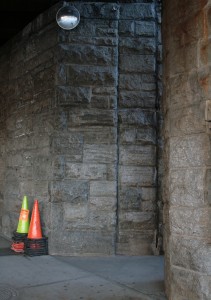In the beginning, The Stoneslide Corrective was an urge. I can’t be any more precise than that, because the urge was not precise; urges don’t tend to be.
This urge did not yet have either form or name, so we tried to describe it. We might have resembled tongue-tied fools walking in circles around Michelangelo’s David, babbling, “I like marble… big… Yes, impressive is good… Beautiful. I like beautiful things.” But somehow we both seemed to understand that the other was talking about the same thing.
As I kept trying to describe this thing I wanted to make, two snatches of other people’s thoughts rattled through the void of my mind.
The first was this anecdote from Boswell’s Life of Johnson. (This is an unbearably pretentious way to start, I know; but bear with me.) Boswell says:
After we came out of the church, we stood talking for some time together of Bishop Berkeley’s ingenious sophistry to prove the non-existence of matter, and that every thing in the universe is merely ideal. I observed, that though we are satisfied his doctrine is not true, it is impossible to refute it. I never shall forget the alacrity with which Johnson answered, striking his foot with mighty force against a large stone, till he rebounded from it, ‘I refute it THUS.’
The act of kicking the stone is what appealed to me. I kept thinking of it. The foot coming down. The hard jolt against the arch of the foot. Perhaps it’s just a personal thing. I like rocks. I like piling them in stone walls and the dull clonks they make when they fall together. I like hauling them from place to place in a wheelbarrow. I like how heavy and damned hard they are to budge. I like their unyielding disregard.
But Johnson striking his foot on the stone was occurring to me for some reason beyond my fetishistic relish. By kicking the stone, Johnson is showing his conviction that the life of the mind must be connected to the actions of the body and the input of the senses. Thought can be led astray when it’s severed from the observable world and the hard, unyielding message it sends through the senses. Johnson’s kick is a positive action and a refutation at once. It’s a choice to build your thought from tangible details, rather than airy and untethered cogitation. I cannot disprove that my experience is illusion, but I refute it. I choose to kick a rock.
Somehow, in my head, this became a refutation of literature whose allure is abstraction, whose coy looks all lead to a sterile word game or pun, that opens its shirt only to reveal bodyless rumination… What we wanted was something harder, something you really feel when you hit it (note that Johnson “rebounds”).
The next piece of stolen thought that helped was a small portion of a monologue from the radio show Entitled Opinions by Robert Harrison. (You’re probably not familiar with Entitled Opinions; go listen.) Harrison was leading into a discussion of Roberto Bolaño’s By Night in Chile, but that doesn’t matter. His point was about why that novel worked.
It’s a book that thinks in all manner of modes — through concepts but also through figures, landscapes, images, emplotment, and a constant interplay between the spoken and the unspoken, the latent and the manifest, the act of telling and the act of showing. In sum, it contains an active invitation to thinking, or an invitation to open thinking.
To me — and perhaps to no one else — this directly relates to Johnson’s kick. In rejecting untethered cogitation, we don’t reject thought. We want a fuller form of thought, one that draws on the plangent senses of the body, the flitting ghosts of unremarked feelings, the accumulation of experience, habituation, and muscle memory in one deft movement, the dawning sense of living in a vast pattern while witnessing its ongoing disruption and destruction, the gaping sympathy that ennobles human beings, our inevitable selfishness. These components of thought, which my words above only hint at, can’t be expressed directly, can’t be crammed into the restraints of logical thought, can’t be widely agreed on — but they can be experienced. This kind of complex, multi-layered thinking is often activated in the most poignant moments. Have you seen a mauve and gold sunset splayed over the horizon as you drive within the barriers of a highway that crushed a once-vibrant neighborhood? Have you seen the expression on your beautiful daughter’s face as she acts with deliberate cruelty?
This form of mind-body thought, replete with contradictions and absurdities, can open to so many channels and, we think, put you in touch with irreducible truth. But it will fade if you try to hold onto it. Holding onto it, trying to make it live and stand in something other than its full context — context that includes the input of the senses, the heart, and the mind, to use broad terms — is like ripping a living plant out of the soil, so that its roots pine in the air.
Now you see why we wanted “stone” in our name — to stand for all of this. We wanted movement in there too, to reflect the importance of narrative to what we’re doing. And we do think the two concepts are closely related. The full and open form of thinking that we have in mind has to be ephemeral and context-dependent. Narrative is the art of building this context — and then letting it go in the unceasing movement of story.
Thus, the one word “stoneslide.”
As for the “corrective”? We do think a lot of fiction misses the point. We do want to do better. But mostly we like to be a little obnoxious, and “corrective” hits the right grating note, we think.
So, after a few weeks of discussion, however many emails, and about a hundred other, wretched ideas (yes, we came up with names worse than “The Stoneslide Corrective”), we had a name. We don’t know how Adam did this for all the birds and the beasts and the creeping things in one day.



